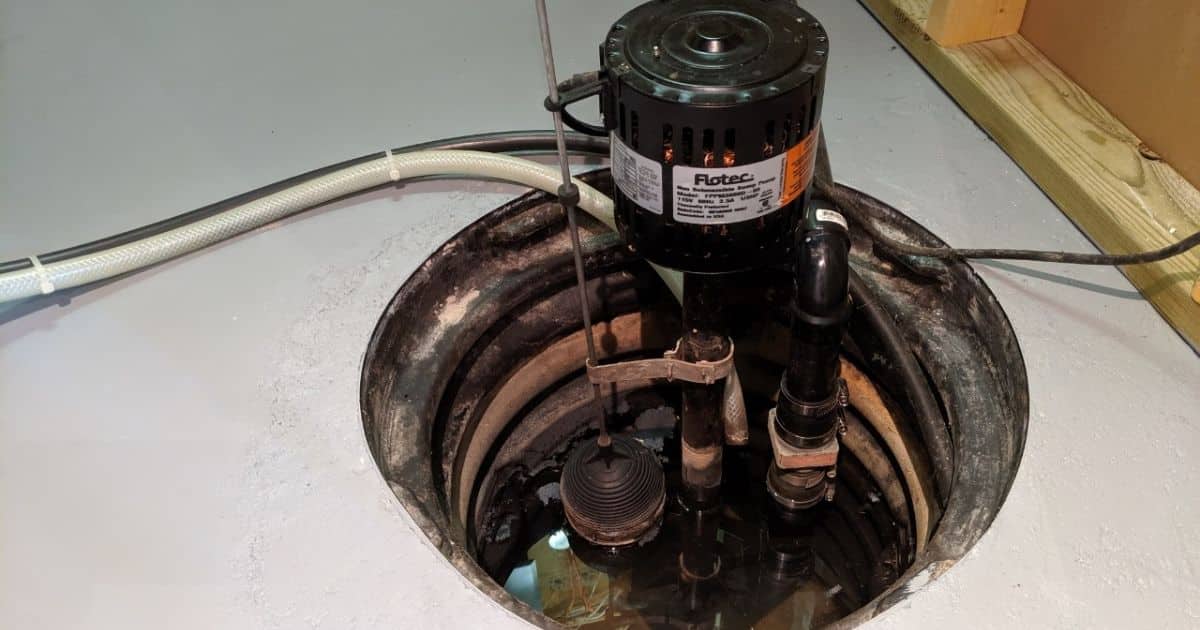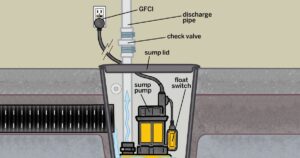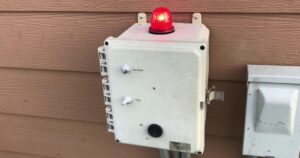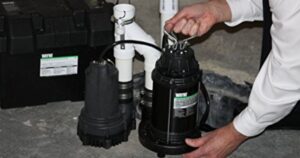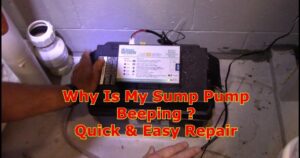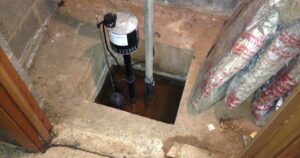When the sump pump alarm goes off, it’s like a piercing cry for help from the depths of your basement. But fear not, for there are concrete steps you can take to address the issue. In this informative and concise guide, we will explore the necessary actions to ensure the smooth operation of your sump pump system. From checking power sources to testing backup systems, we will provide practical solutions for when the sump pump alarm disrupts your sense of belonging in a dry and secure home.
Key Takeaways
- Check the power source of the sump pump alarm, including the power cord and electrical outlet.
- Inspect the float switch for malfunctions and ensure correct positioning and wiring connections.
- Clear any debris or blockages in the sump pit to maintain efficient sump pump operation.
- Test and maintain the sump pump backup system, including checking battery power and inspecting terminals.
Check the Sump Pump Power Source

To troubleshoot a sump pump alarm going off, begin by checking the power source using an appropriate voltage tester. Start by inspecting the power cord for any signs of damage or wear. Look for frayed wires, exposed insulation, or loose connections.
If any issues are found, replace the power cord immediately to ensure safe and reliable operation of the sump pump. Next, check the electrical outlet that the sump pump is plugged into. Make sure the outlet is functioning properly by plugging in another device and testing if it works. If the outlet is not working, reset the circuit breaker or replace the fuse.
Ensure that the outlet is providing the correct voltage for the sump pump to operate efficiently. By inspecting the power cord and checking the electrical outlet, you can resolve any power-related issues that might be causing the sump pump alarm to go off.
Inspect the Sump Pump Float Switch
When dealing with a sump pump alarm, it is important to inspect the float switch as it is a common source of issues. The float switch is responsible for activating the pump when the water level rises, so any malfunction can cause the alarm to go off. By troubleshooting the float switch, you can identify and resolve any problems, ensuring your sump pump operates effectively.
Common Float Switch Issues
Float switch malfunction is a common issue to investigate when experiencing a sump pump alarm. The float switch is responsible for detecting the water level in the sump pit and activating the pump when necessary. If the float switch is not functioning properly, it can lead to pump failure and potential flooding. Here are four common float switch issues to be aware of:
- Stuck float: A stuck float can prevent the switch from moving freely and activating the pump. Check for any debris or obstructions that may be causing the float to stick.
- Incorrect positioning: Ensure that the float switch is properly positioned at the desired water level. Adjust it if necessary to ensure proper pump activation.
- Faulty wiring: Inspect the wiring connections of the float switch for any loose or damaged wires. Tighten or replace them as needed.
- Age and wear: Over time, the float switch may deteriorate or become worn out. If other troubleshooting methods do not resolve the issue, consider replacing the float switch or the entire sump pump if necessary.
Troubleshooting Sump Pump

One crucial step in troubleshooting a sump pump is inspecting the functionality of the float switch. The float switch is responsible for activating the pump when the water level in the sump pit rises. If the switch is not functioning properly, it can cause common sump pump problems such as failure to turn on or off, resulting in potential flooding or damage. To troubleshoot the float switch, start by checking for any debris or blockages that may be obstructing its movement. Additionally, ensure that the switch is properly aligned and not stuck in one position. If the switch appears to be damaged or faulty, it may need to be replaced. By addressing float switch issues, you can effectively troubleshoot sump pump noise and prevent any further complications.
Now, let’s move on to the next step: clearing any debris or blockages in the sump pit.
Clear Any Debris or Blockages in the Sump Pit
To address any potential issues causing the sump pump alarm to go off, it is crucial to inspect and remove any debris or blockages within the sump pit. This simple maintenance task can help prevent clogs and ensure the proper functioning of your sump pump. Here are four cleaning techniques and maintenance tips to clear any debris or blockages in the sump pit:
- Wear protective gloves and use a flashlight to carefully examine the sump pit for any visible debris such as dirt, gravel, or leaves.
- Use a small shovel or scoop to remove any larger debris that may be obstructing the pump or impeller.
- Flush the sump pit with water to dislodge any smaller debris or sediment buildup.
- Consider installing a sump pit cover or screen to prevent future debris from entering the pit.
Regularly clearing debris and blockages from the sump pit will help ensure your sump pump operates efficiently and reduces the risk of potential malfunctions.
Test the Sump Pump Backup System
To ensure the effectiveness of your sump pump backup system, there are two key points to consider: checking the battery power and inspecting the pump connections. First, make sure the battery is fully charged and functioning properly, as a backup system relies on it during power outages. Second, inspect the pump connections for any loose or damaged parts that may hinder its performance. By addressing these points, you can ensure that your sump pump backup system is ready to provide reliable protection for your basement.
Check Battery Power
Inspect the battery power of the sump pump backup system to ensure proper functionality. To do this, follow these steps:
- Inspect battery terminals: Check for any signs of corrosion or loose connections. Clean the terminals if necessary and tighten any loose connections to ensure a secure connection.
- Test battery voltage: Use a voltmeter to measure the voltage of the backup system’s battery. The voltage should be within the manufacturer’s recommended range. If it is below the specified voltage, consider replacing the battery.
- Verify battery charger: Check the battery charger to ensure it is plugged in and functioning correctly. Make sure the charger is providing a steady charge to the battery.
- Consider a battery backup system inspection: If you are unsure about the battery’s condition or the backup system’s overall functionality, it may be beneficial to schedule a professional inspection.
Inspect Pump Connections
A thorough examination of the pump connections is essential to ensure the proper functioning of the sump pump backup system. Start by inspecting the pump motor. Check for any loose or disconnected wires, as these can affect the pump’s ability to operate effectively. Make sure all electrical connections are secure and free from any signs of damage. Additionally, it is important to check the sump pump discharge. Ensure that the discharge pipe is properly connected and free from any obstructions. A clogged or disconnected discharge pipe can prevent the pump from effectively removing water from the sump pit. By regularly inspecting the pump connections, you can identify and address any issues that may compromise the performance of your sump pump backup system.
Consider Installing a High-Water Alarm System
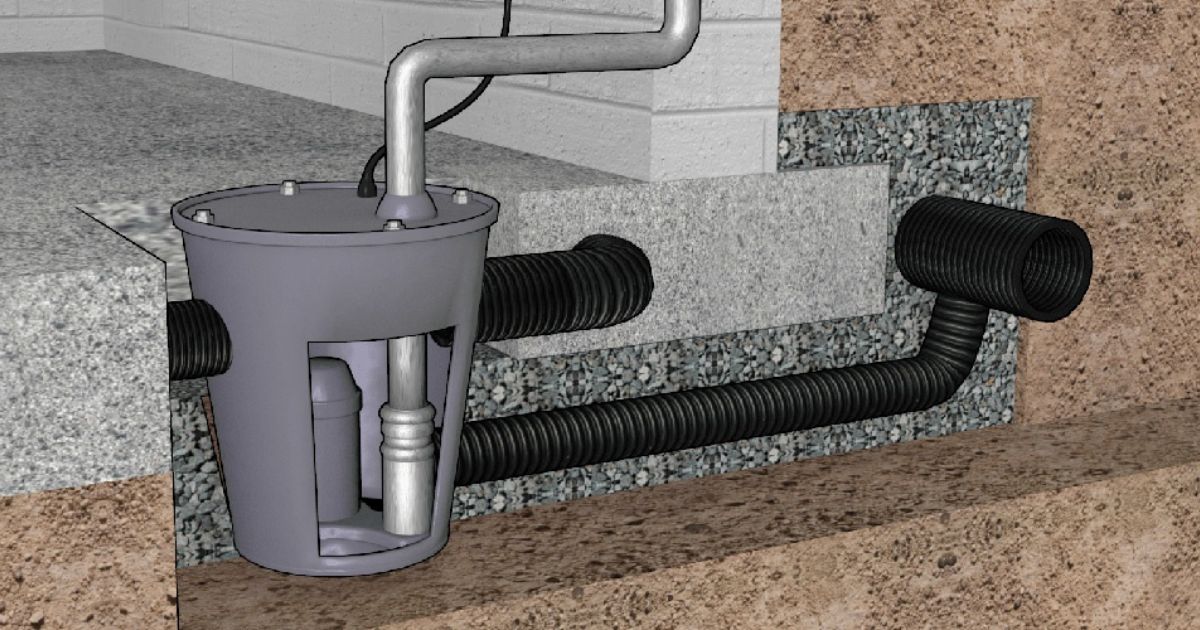
When dealing with a sump pump alarm going off, it is essential to consider the installation of a high-water alarm system. This system provides an extra layer of protection for your basement by alerting you to rising water levels before they cause any damage. Here are four reasons why installing a high-water alarm system is beneficial:
- Early warning: A high-water alarm system will notify you as soon as water levels reach a predetermined threshold, allowing you to take immediate action.
- Peace of mind: By having a high-water alarm system in place, you can have peace of mind knowing that you will be alerted to any potential flooding issues.
- Prevent damage: With early detection, you can take prompt action to prevent water damage and protect your valuable belongings.
- Cost-effective: Investing in a high-water alarm system is a cost-effective way to avoid costly repairs and insurance claims associated with water damage.
Considering the benefits of a high-water alarm system, it is a wise choice to have one installed in your basement. However, if you are unsure about the installation process, it is recommended to contact a professional for assistance.
Contact a Professional for Assistance, if Necessary
If you are unsure about the installation process or require expert guidance, it is advisable to seek the assistance of a professional. Troubleshooting a sump pump or its alarm can be a complex task, and it is essential to have someone with experience to help you navigate through it.
A professional can provide you with the necessary expertise to diagnose and fix any issues with your sump pump or its alarm system. They will have the knowledge and tools to identify potential problems, such as clogs, pump failure, or electrical issues.
A professional can guide you on the proper maintenance and care of your sump pump to ensure its optimal performance. When it comes to troubleshooting a sump pump or its alarm, reaching out to a professional is the best course of action to ensure the safety and functionality of your system.
Frequently Asked Questions
How Can I Determine if the Sump Pump Power Source Is the Cause of the Alarm Going Off?
To determine if the sump pump power source is causing the alarm to go off, you can start by testing the power supply and checking for any issues such as tripped circuit breakers. Additionally, troubleshooting the float switch can help identify any problems.
What Should I Do if the Sump Pump Float Switch Is Not Functioning Properly?
If the sump pump float switch is not functioning properly, it is important to conduct a thorough troubleshooting of the power source and inspect for any repairs needed. Prompt action is necessary to prevent potential flooding risks.
Are There Any Specific Types of Debris or Blockages That Commonly Cause Sump Pump Alarms to Go Off?
Common causes of sump pump alarms going off include blockages from debris such as dirt, leaves, or small objects. Troubleshooting sump pump alarms involves checking for these obstructions and clearing them to ensure proper functioning.
How Can I Test the Sump Pump Backup System to Ensure It Is Working Correctly?
To test the sump pump backup system and ensure its proper functioning, follow a testing procedure that includes checking power sources, inspecting float switches, and verifying the pump’s activation during a simulated power outage. Troubleshooting tips are available for resolving any issues encountered.
What Are the Benefits of Installing a High-Water Alarm System in Addition to a Sump Pump?
Installing a high-water alarm system in addition to a sump pump provides several benefits. It ensures timely notification of potential flooding, allows for prompt action, and helps prevent costly water damage. Regular maintenance is crucial to ensure the system functions optimally.
Conclusion
In conclusion, when faced with a sump pump alarm going off, it is crucial to take immediate action. By checking the power source, inspecting the float switch, clearing any debris or blockages, testing the backup system, and considering a high-water alarm system, you can effectively address the issue. And remember, if all else fails, don’t hesitate to seek professional assistance. After all, you don’t want your basement turning into a water park. Learn more “How to clean a sump pump pit?”
